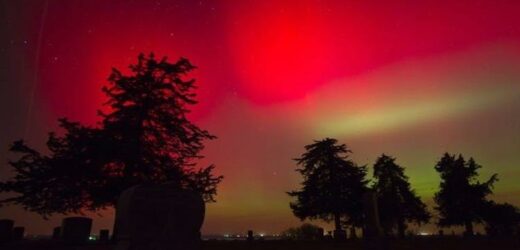Earth’s ‘magnetic song’ captured during solar storm
We use your sign-up to provide content in ways you’ve consented to and to improve our understanding of you. This may include adverts from us and 3rd parties based on our understanding. You can unsubscribe at any time. More info
Space weather forecasters in the US have issued a solar storm warning for Thursday, citing an increase in geomagnetic activity in the planet’s magnetosphere. The “G3 Strong” warning was issued by the US Space Weather Prediction Center (SWPC) after the Sun erupted billions of tons of plasma and magnetic field towards the planet on Tuesday. According to the website SpaceWeather.com, the CME overtook and “swallowed” at least one other previous CME before crashing into Earth – a phenomenon by some know as a Cannibal CME.
The website explained: “What is a Cannibal CME? It’s a CME that eats its own kind.
“On November 2, sunspot AR2981 hurled a fast CME towards Earth.
“As it approached our planet, it overtook at least one other CME and swallowed it.
“The mashed-up pair struck Earth on November 3 (8pm UTC).”
The resulting impact has triggered a G3-class solar storm that has created beautiful aurora effects in the Arctic Circle and beyond.


Auroras are caused by charged particles from the Sun crashing into the atmosphere, exciting atoms and molecules of gas to new energy levels.
As the atoms give off the excess energy, they release it in the form of photons (light), producing dazzling displays of multi-coloured streaks of light.
Although auroras are typically limited to the northern or southernmost parts of the globe, intense solar storms can push them farther away from the poles.
In the Northern Hemisphere, these are known as the Northern Lights (Aurora Borealis) and in the south, these are the Southern Lights (Aurora Australis).
So far, the Northern Lights have been seen as far south as the state of Oklahoma in the south-central US.
Even more intriguingly, the auroras took on a deep red hue, which is a fairly rare phenomenon that is associated with stronger solar activity at mid-latitudes.
Astrophotographer Paul Smith tweeted a photo of the auroras painting the night skies red along the star-lit horizon at about 4:09am UTC.
The image was retweeted by solar physicist Dr Tamitha Skov who has been tracking the solar storm’s arrival.
She tweeted: “Confirmed! Red storm-time #aurora in Oklahoma, USA! This is crazy-cool.
“We’re seeing sporadic G3 levels during this ongoing #solarstorm, which means flare-ups with views like this, dipping deep into mid-latitudes, continue to be possible tonight! Thank you for the stellar report!”


Dr Skov retweeted another photo snapped by self-described aurora chaser and podcaster, Alistair Hamill.
His photo features an intense green glow lighting up the horizon at Slemish, County Antrim, in Northern Ireland.
The astrophotographer tweeted: Goodbye those long, lonely years of solar minimum.
“Hello two aurora displays in five days!!! The chase has well and truly begun!”
According to the SWPC, the solar storm will likely persist through Thursday, although its intensity will waver between G1 and G3.
This means it will be possible to see auroras in parts of the UK tonight, according to the AuroraWatch UK team at Lancaster University.
Solar storms are ranked on a scale of “G1 Minor” to “G5 Extreme”.
At the far end of the scale, extreme storms have the potential to knock out satellites, disrupt communications and even cause some power grid systems to collapse.
At G3 level, satellites may experience increased drag from the atmosphere and there may be intermittent problems with satellite navigation and low-frequency radio navigation.
Source: Read Full Article


